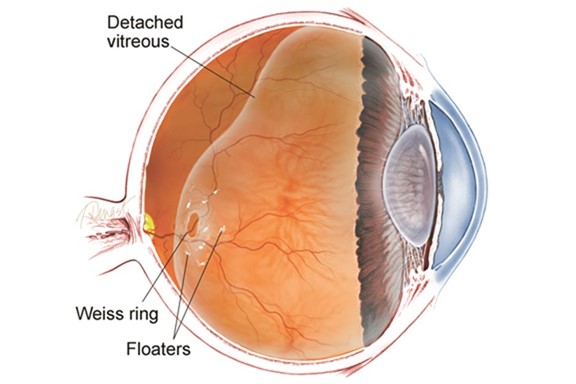Posterior Vitreous Detachment (PVD)
Seeing Floaters or Flashes across your vision can be a sign of a Posterior Vitreous Detachment (PVD). Although a PVD in itself is not a worrying condition, flashes and floaters can be a sign of a retinal tear or retinal detachment and needs review.
Your eyeball is filled with a clear gel called Vitreous Humour (as in 'glass like'). You'll probably hear the name shortened to just Vitreous.

In PVD your vitreous develops a gap where it meets the retina. It isn't painful and it doesn't cause loss of sight, but you may have symptoms like floaters or flashing lights. Your brain is so good at adapting and compensating for minor visual glitches, that many people with PVD will never realise they have it.
That said, PVD is definitely something to be taken seriously. Between 10 to 15 percent of people with PVD can develop a retinal tear, which is serious and can cause loss of sight. If you notice changes in your vision, particularly if they are sudden, always get it checked by a professional.
So what causes PVD?
As we get older, our vitreous gets more watery and less gel like. Like a too soft jelly, it sags and losses its shape, pulling away from the retina in places.
It doesn't often occur if you are under 50 unless you are short sighted or had an eye injury. When it does happen it usually affects the other eye soon after.

Living with PVD and its symptoms
Floaters are very common and many people have them, even if they don’t have PVD. They’re floating clumps of cells that form in your vitreous. You can see them because they cast shadows on your retina when light comes into your eye. These floaters do not harm your eye.
Dots, threads, circles, clouds, spiders or cobwebs, your floaters may move around a lot or they may not seem to move much at all. They tend to be more obvious on a sunny day or when looking at a bright computer screen or white or lightly coloured background.
Floaters are more worrying and irritating than being a problem for vision. Floaters never leave the eye but become less noticeable as the vitreous settles down and your brain learns to ignore them. Wearing sunglasses in bright conditions can help.
The other common symptom, flashes of light, is caused when the vitreous pulls away from the retina and causes it to send a signal that the brain interprets as a flash of light. Seeing these tends to happen at a particular stage in the progress of the condition and become a lot less frequent.
Is there a cure for PVD?
The honest answer is, not really. You may find articles suggesting that laser or other surgical interventions can remove floaters or even the vitreous in your eye (vitrectomy). These procedures are not without risk and it is usually best to avoid doing things that can make the situation worse.
For most people, PVD does not cause any long term changes to their sight.
In a small number of people, PVD is associated with the formation of a retinal tear which can lead to retinal detachment. Such tears can be treated and if done so promptly it is very successful. This is the reason why PVD is carefully monitored.
Another associated event can be small bleeds in the ye (vitreous haemorrhage) that presents itself as a shower of black floaters and blurring of vision. It is the sort of things you'll notice. Fortunately, the fragments of blood will be reabsorbed and will clear over the course of a few months.
The first few months after a new onset PVD
As with all things, common sense usually works as well as learned medical opinion.
Although there is no clear evidence that activities which jolt the head can cause or worsen PVD, it never hurts to apply the precautionary principle. Certainly at a stage where the vitreous has not yet fully detached from the retina.
Go easy on lifting heavy weights. Moderate high impact exercise. Standing on you head in yoga or pilates may not be such a great idea.
Outside of that, live life to the full. There is no suggestion that contact lenses, flying or normal activities will affect your PVD.
How can we help at the Hampshire Clinic?
If you experience anything from the list below and would like an honest, friendly and professional opinion, contact us using the form provided, contact us via email …………or call us on…………… These symptoms can happen in other conditions and we can guide you to the most appropriate care.
- Floaters for the first time or more floaters than you had before? The new floaters are usually noticed suddenly. There may be lots of new floaters or commonly a large cobweb-like floater
- Flashes of light in your vision, usually like brief ‘streaks’ of light in your side (peripheral) vision
- Blurred vision.
FAQs
If you experience any of the symptoms from the list above and would like an honest, friendly and professional opinion, contact us using the form provided, via email info@privateophthalmologist.co.uk or call 07949 767906. These symptoms can happen in other conditions and we can guide you to the most appropriate care.
Quality care in a relaxing surrounding
Book an appointment to see Mr Nish Srikantha at the Candover clinic in Basingstoke, or the Healthshare Clinic in Winchester.
Both locations are modern purpose built private hospitals designed entirely for patient well-being and comfort. The Candover Clinic is a stand-alone unit located on the Basingstoke and North Hampshire Hospital. The Healthshare Clinic on the outskirts of Winchester boasts a purpose built ophthalmic outpatients department and operating theatre offering the latest diagnostic and treatment technologies.













